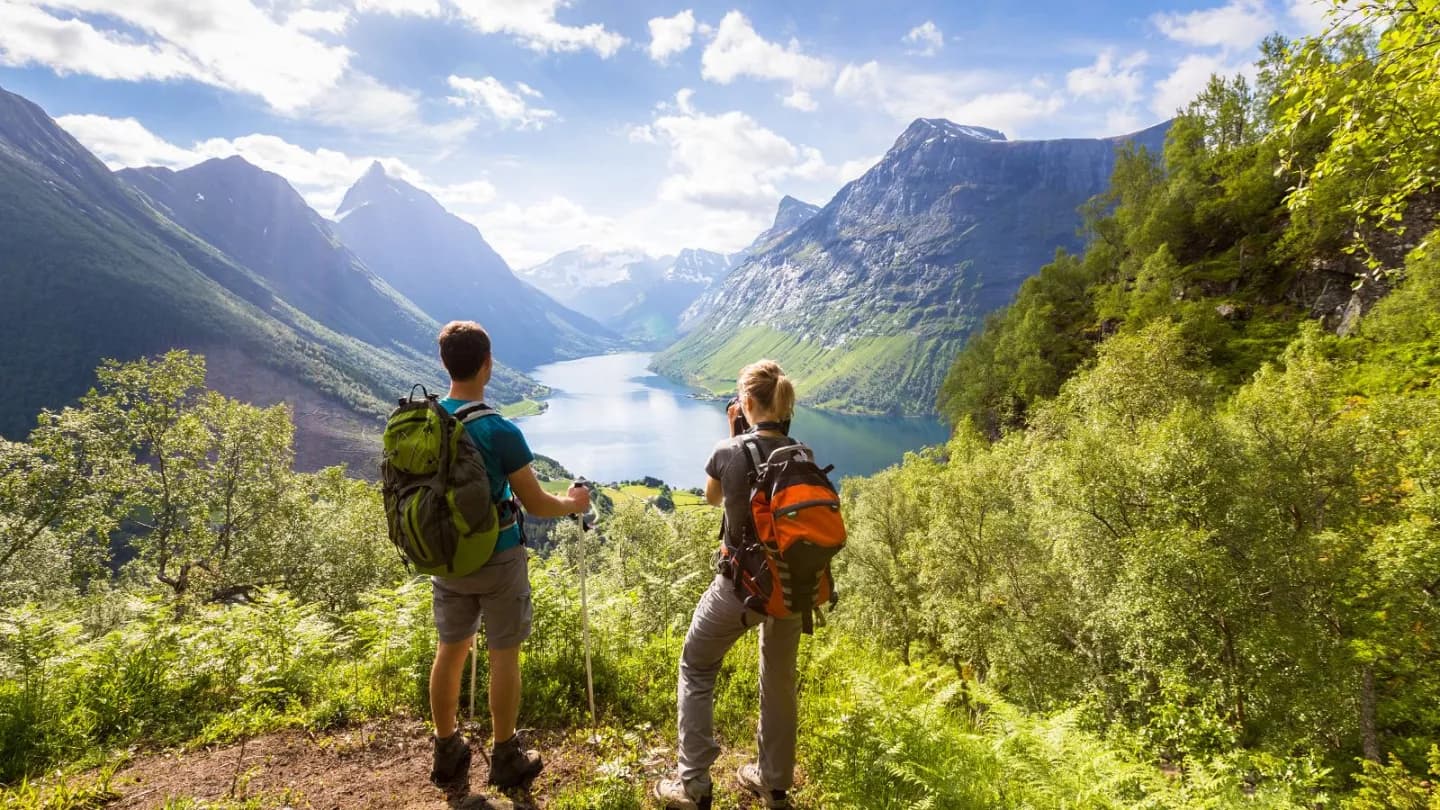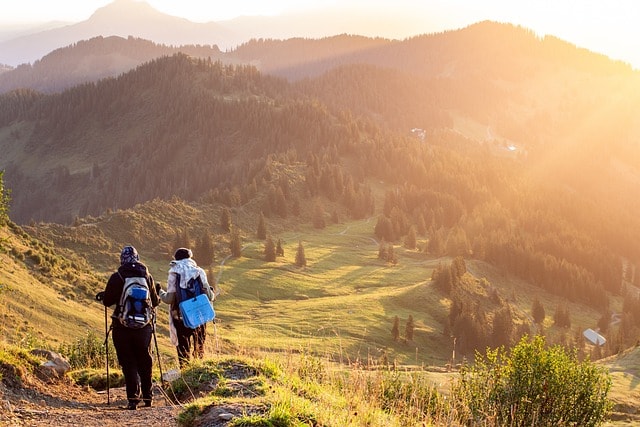Note: This post contains Amazon affiliate links. We may earn a commission from purchases at no extra cost to you.
Welcome to the easy guide for beginner hikers! Your first hikes must be memorable and easygoing. We’ve got all the info you need to make your hike fun and safe. With the right gear and planning, you can enjoy the great outdoors. The American Hiking Society promotes safe hiking practices and supports trail maintenance. Plus, we’ve added some links to gear we recommend to help you get started.
So, why hiking?
Hiking can be so many things. From love to nature, reconnecting with yourself, to escaping the everyday stress. Like most cardio exercises, hiking helps reduce your risk of heart disease, and stroke, improves sleep quality, reduces your blood pressure and cortisol levels produces a calming effect, and reduces high cholesterol and even some cancers. Hiking is a weight-bearing exercise, which builds muscle mass and helps prevent osteoporosis. Hiking clears the mind and reduces stress. The benefits are numerous. Organizations like the American Hiking Society are preparing the next generation of hikers and trail stewards.
MUST-HAVE GEAR FOR BEGINNERS
Before you go hiking, make sure you have the right stuff. Here’s a list of things you’ll need to make your hike comfy and fun:
1. HIKING BOOTS
Good boots are important for comfort and safety. Look for boots with ankle support and a strong sole.
Recommended for her: Columbia Women’s Newton Ridge Plus Waterproof Amped Hiking Boot
Recommended for him: Columbia Men’s Newton Ridge Plus Ii Suede Waterproof Hiking Boot
2. BACKPACK
A good backpack is needed to carry all your stuff. Choose one with comfy straps and lots of pockets.
Recommended: Osprey Hikelite Unisex Hiking Backpack
3. WATER BOTTLE
Stay hydrated with a strong, reusable water bottle.
Recommended: Hydro Flask Water Bottle
4. NAVIGATION TOOLS
Always bring a map and compass, and think about getting a GPS device. Mapping out a hiking route is crucial to ensure you stay on track and make the most of your journey.
Recommended: Garmin eTrex 10 Worldwide Handheld GPS
5. FIRST AID KIT
A small first aid kit is helpful for minor injuries. Be prepared for the physical toll of hiking long distances, especially on rugged terrain.
Recommended: Adventure Medical Kits Ultralight/Watertight .7 Medical Kit
6. CLOTHING
Dress in layers to stay comfy. Quick-dry shirts, warm layers, and waterproof jackets are key.
Recommended for her: Columbia Women’s Fork Stream Long Sleeve Shirt
Recommended for her: The North Face Venture 2 Waterproof Jacket
Recommended for him: Columbia Men’s Long Sleeve Shirt
Recommended for him: Columbia Men’s Watertight Rain Jacket
TIPS FOR A GREAT HIKE
Start Small
Begin your hiking journey with short, easy trails to build your stamina. There are various hiking trails offering spectacular views, wildflowers, and wildlife sightings, and it's important to conserve these natural landscapes. Starting small allows you to get comfortable with hiking and build the necessary physical endurance. As you get better, try longer and harder hikes. Remember, every hiker's journey begins with a single step, and gradually increasing your hiking speed and distance helps prevent injuries and builds confidence.
Plan Ahead
Research your trail before you go. Check the weather, trail conditions, and any potential hazards. Planning ahead ensures that you are prepared for your adventure and can handle any challenges that might arise. Inform a friend or family member of your plans and when you’ll be back. This precaution is essential in case of emergencies. Knowing your route and expected return time can be a lifesaver if you encounter danger or get lost.
Pack Light
Only bring what you need to keep your backpack light. Overpacking can make your hike difficult and slow your speed. Essential items include water, snacks, a first aid kit, a map, and sun protection such as sunscreen and a hat. Maintaining a steady pace during your walk is crucial for an enjoyable hike. Too much stuff can make your hike hard, so prioritize the necessities and leave non-essential items behind.
Stay Hydrated and Fueled
Drink lots of water and bring snacks like nuts, dried fruit, and energy bars to keep your energy levels up. Hydration is critical to maintain your body’s performance and prevent dehydration, especially on longer hikes. Snacks provide a quick energy boost and help sustain your strength. Recommended: Clif Energy Bars are a great choice for their convenient size and nutritional value, keeping you fueled throughout your hiking journey.
Respect Nature
Stay on marked trails, dispose of waste properly, and respect wildlife. Following Leave No Trace principles is vital to keeping nature beautiful and ensuring that other groups of hikers can enjoy the trails as well. Respecting nature means not disturbing the wildlife and minimizing your impact on the environment. Inspired by the natural beauty around you, practice good stewardship to preserve these outdoor adventures for future generations.
Use Sun Protection
Protecting yourself from the sun is essential during any hike. Apply sunscreen, wear a hat, and bring sunglasses to shield your skin and eyes from harmful UV rays. Long exposure to the sun can lead to sunburn and heat exhaustion, so take necessary precautions.
Hike with a Friend
If possible, hike with a friend or join a group. Hiking with others provides added safety and can make the experience more enjoyable. You can support each other, share the adventure, and be more prepared to handle emergencies. Hiking in a group reduces the risk of encountering danger alone and ensures that there’s always someone to help if needed.
Know Your Limits
Listen to your body and know your limits. It’s okay to take breaks and go at a slower pace if needed. Overexertion can lead to injuries and fatigue, diminishing the enjoyment of your hike. Recognize the signs of physical strain and rest when necessary.
Stay Informed and Inspired
Continuously educate yourself about hiking techniques, safety tips, and new trails. Reading about other hikers' experiences and adventures can inspire you and provide valuable insights. Staying informed helps you become a more skilled and confident hiker.
Finding the Best Trail
Finding the perfect hiking trail can significantly enhance your outdoor experience. Whether you seek breathtaking mountain views, peaceful woodland walks, or challenging terrain, there are numerous resources and strategies to help you discover the best trails. Here are some tips and tools for finding the ideal hiking trails.
Use Apps and Websites
In the digital age, there are many apps and websites dedicated to helping hikers find the perfect trail. These platforms provide detailed information on trail length, difficulty, user reviews, and even real-time updates on trail conditions. They often highlight trails with stunning mountain views that offer a sense of healing and revitalization.
- AllTrails App: One of the most popular hiking apps, AllTrails, offers an extensive database of hiking trails worldwide. It provides GPS navigation, user reviews, photos, and difficulty ratings. You can search for trails by location, skill level, or specific features, such as waterfalls or mountain views. The app is particularly useful for finding trails that suit your preferences and fitness level, ensuring a safe and enjoyable hike.
Join Local Hiking Groups
Connecting with local hiking groups is a great way to get trail recommendations and hike with experienced hikers. These groups often organize regular hikes and are an excellent resource for discovering lesser-known trails and gaining valuable hiking tips.
- Trail Recommendations: Experienced hikers in these groups can recommend trails that might not be listed on popular apps or websites. They can provide insights into trail conditions, scenic spots, and potential dangers.
- Social Aspect: Hiking with a group can be more enjoyable and safer, especially for beginners. It offers the opportunity to meet new friends, share the hiking experience, and learn from others.
Visit National Parks
National parks are treasure troves of well-maintained hiking trails for all skill levels. Some of the best hikes in the world can be found in these parks, showcasing the global appeal of hiking.
- Trail Variety: National parks typically offer a wide range of trails, from easy, flat paths suitable for families to challenging mountain trails for experienced hikers. This variety makes them an ideal destination for hikers of all abilities.
- Scenic Beauty: Many national parks feature breathtaking landscapes, including mountains, forests, lakes, and waterfalls. Hiking in these parks provides an opportunity to immerse yourself in nature's beauty and enjoy some of the most stunning views in the world.
- National Park Service Website: For those in the United States, the National Park Service website is an excellent resource for finding detailed information on trails within national parks. It offers maps, trail descriptions, and safety tips, helping you plan your hikes more effectively.
Consider Your Preferences and Fitness Level
When choosing a trail, it's important to consider your personal preferences and fitness level. Here are some factors to keep in mind:
- Difficulty: Ensure the trail matches your hiking experience and fitness level. Starting with easier trails and gradually progressing to more challenging ones can help build your strength and confidence.
- Scenery: Think about the type of scenery you enjoy. Do you prefer mountain views, forested paths, or coastal trails? Select a trail that offers the kind of environment you find most appealing.
- Weather: Consider the weather conditions. Hiking in the cold requires proper gear and preparation, while summer hikes necessitate sun protection and hydration. Adjust your trail choice based on seasonal conditions to ensure a comfortable and safe hike.
Utilize Hiking Guides and Maps
Hiking guides and maps are traditional but highly reliable resources for finding and navigating trails. These tools often provide detailed topographic information, trail distances, and landmarks.
- Guidebooks: Hiking guidebooks are available for many regions and often include detailed descriptions of trails, including difficulty ratings, estimated hiking times, and points of interest. They are invaluable for planning longer hikes or exploring unfamiliar areas.
- Topographic Maps: Topographic maps provide a detailed representation of the terrain, including elevation changes, which are crucial for planning hikes in mountainous or hilly areas. Knowing the elevation gain and trail layout helps you prepare for the physical demands of the hike.
Stay Informed About Trail Conditions
Trail conditions can change due to weather, maintenance, or natural events. Staying informed about current trail conditions helps ensure a safe and enjoyable hike.
- Local Ranger Stations: Contacting local ranger stations can provide up-to-date information on trail conditions, closures, and any potential dangers.
- Online Forums and Social Media: Hiking forums and social media groups often share recent trail reports and photos. These platforms can offer real-time insights from fellow hikers who have recently been on the trails you are considering.
Equip Yourself Properly
Regardless of the trail you choose, being properly equipped is essential for a safe hiking experience. Here are some key items to consider:
- Footwear: Invest in good hiking boots or shoes that provide support and traction suitable for the trail conditions.
- Clothing: Wear moisture-wicking layers to stay comfortable and dry. In colder weather, pack additional layers, gloves, and a hat to keep warm.
- Hydration and Nutrition: Carry plenty of water and high-energy snacks. Hydration systems or water bottles with filters are useful for longer hikes.
- Safety Gear: Always have a first aid kit, map, compass, and a fully charged phone. Consider carrying a whistle and a flashlight for emergencies.
By utilizing these tips and resources, you can find the best hiking trails that match your preferences and abilities. Whether you're seeking serene mountain vistas, engaging social hikes with friends, or challenging trails to test your fitness, the right trail is out there waiting for you.
CONCLUSION
Hiking is a great way to enjoy nature and stay active. By following these tips and bringing the right gear, you’ll be ready for a fun and safe hiking adventure. Remember, planning is key to having a great first hike. Happy hiking!


